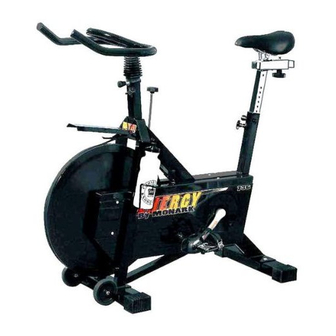
Table of Contents
Advertisement
Quick Links
Advertisement
Table of Contents

Subscribe to Our Youtube Channel
Summary of Contents for Monark energy 736
- Page 1 INSTRUCTION MANUAL Monark Energy model 736...
-
Page 3: Table Of Contents
CONTENTS Assembly instructions Brake belt contact surface – Brake belt Chain 12-13 Crank bearing Flywheel bearing General General about exercise 15-17 Operation instructions Replacement of brake belt Service routine check Warranty... -
Page 4: General
This guarantee does not apply to cases of abuse or vandalism, nor does it extent to any injury or loss to person or property caused directly or indirectly by any Monark products. In the event of a defect material or workmanship during the warranty period, Monark will repair or replace (at its option) the product. -
Page 5: Assembly Instructions
THE PARTS SHOWN BELOW ARE NOT ASSEMBLED: ASSEMBLED INSTRUCTIONS. See pages 5-8. HANDLEBAR PEDAL, LEFT PEDAL, RIGHT SUPPORT TUBE, FRONT SUPPORT TUBE, REAR ADJUSTMENT WHEEL... - Page 6 Fig. 1 Production number Tip the cycle forward. Assemble the rear support tube with two bolts and two nuts. Note: Use the accompanying spanner. See fig. 1. Fig. 3 The saddle post is back to front when packed and needs rotating 180 degrees. Position the saddle facing forwards on the saddle post.
- Page 7 Screw in the adjustment wheel. See fig 4. Insert the handlebar stem into the head tube and tighten firmly by means of the wheel lever. The handlebar stem can be set in five different height positions. See fig 4. Fig 4 L Left The pedal marked R (Right) to be assembled on the right hand side of the cycle (the chain wheel side).
- Page 8 Fig. 6 Loosen the brake belt and remove the tape from the flywheel. Assemble the brake belt as before. See fig 6. NOTE: It is very important that all of the tape is removed. Residue of the plastic tape may cause an uneven operation.
-
Page 9: Operation Instructions
OPERATIONS INSTRUCTIONS The Monark exercise cycle model 736 is provided with a brake system which can easily and quickly be adjusted. The same lever is also the emergency brake. When pedalling the user generates enormous kinetic energy to the flywheel. The kinetic energy is reduced by means of a brake belt, which runs around the bigger part of the brake surface of the flywheel. -
Page 10: Replacement Of Brake Belt
REPLACEMENT OF BRAKE BELT Remove the rear chain guard by undoing the mounting screw (M5x6.5mm) at the top and unclipping the white guard holder underneath. Move the chain guard backwards to remove it. Remove the end cap at the top of the front forks. Slide out the brake belt-retaining pin. -
Page 11: Brake Belt Contact Surface - Brake Belt
BRAKE BELT CONTACT SURFACE AND BRAKE BELT The brake belt should be regularly checked to ensure that it has not suffered execessive wear. If it looks worn it should be replaced. Due to the stress placed on the brake belt when the emergency brake is used the belt is more likely to break when needed in an emergency than through normal wear. -
Page 12: Chain
CHAIN ½ x 1/8“ It is strongly recommended that a cahin solvent be used to keep the chain clean. Excess dirt built up on the chain will cause excess wear. A chain lubricant and solvent for normal road bikes may be uaed. Check the lubrication and tension of the chain at regular intervals. -
Page 13: Chain
Chain adjuster Axle nut Chain play Fig. 9 Lock spring Chain lock Fig. 10... -
Page 14: Crank Bearing
CRANK BEARING The crank bearing is long term greased and needs normally no supplementary lubrication. If problem arises, please contact your Monark dealer. FLYWHEEL BEARING The bearings in the flywheel are lifetime greased and require normally no maintenance. If problem arises, please contact your Monark dealer. -
Page 15: General About Exercise
THE IMPORTANCE OF REGULAR EXERCISE The human body is built for action – not for the rest. Once upon a time this was a necessity: the struggle for survival demanded good physical condition. But optimal function can only be achieved by regularly exposing the heart, circulation, muscles, tendons, skeleton and nervous system to some loading, i.e. - Page 16 What kind of exercise to choose? You should have fun when exercising. Choose something you find pleasure in doing regularly. To get a good effect out of the training you should choose a form of exercise that engages large muscle groups. Then the demand of increased blood flow and oxygen transport will be so great that heart will increase its pump capacity.
- Page 17 DO I GET STRONGER? Cycling strengthens the muscles of the back, abdomen and legs. Daily chores become easier. Cycling also makes your heart stronger. Your pulse rate gets lower even when you exert yourself a little extra. Regular exercise also has a favourable influence on high blood pressures. HOW DO I TRAIN? Condition training: Warm up 3-5 minutes with a low pedal resistance.
- Page 18 SE-78050 Vansbro, Sweden SE-432 82 Varberg, Sweden Tel: +46 0281 594940 Tel: +46 0340 86000 Fax:+46 0281 71981 Fax:+46 0340 80485...















Need help?
Do you have a question about the energy 736 and is the answer not in the manual?
Questions and answers